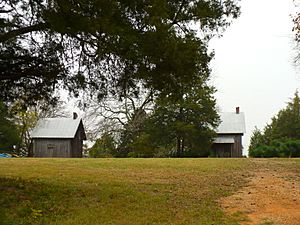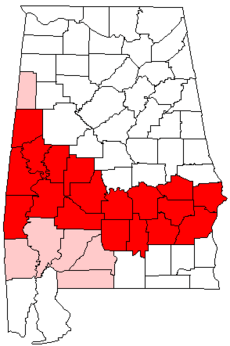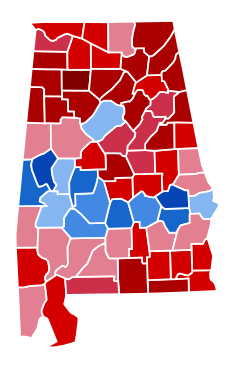Black Belt (region of Alabama) facts for kids
The Black Belt is a special region in the U.S. state of Alabama. It got its name because of its rich, dark topsoil, which is great for farming. Later, the name also came to describe the people living there. In the 1800s, this area became known for large cotton farms called plantations. Many enslaved African Americans were forced to work on these farms.
After the American Civil War, many freed people stayed in the Black Belt. They often worked as sharecroppers or tenant farmers. This meant they rented land and paid with a share of their crops. For a long time, African Americans made up most of the population in many of these counties.
The idea of the "Black Belt" also refers to a larger area across the Southern United States. This bigger region stretches from Delaware to Texas. It includes parts of Georgia, Alabama, Mississippi, and Louisiana.
For many years, the wealthy white landowners in Alabama's Black Belt had a lot of power in state politics. This continued until the 1960s. Like other Southern states, Alabama passed laws that made it very hard for most Black people, and even some poor white people, to vote.
Also, the state government did not redraw voting districts to match population changes for many years. This meant that growing cities like Birmingham had less say in government. Montgomery, the biggest city in the Black Belt, has been Alabama's capital since 1846. Montgomery, Selma, and other parts of the Black Belt were very important during the Civil Rights Movement from the 1950s to the 1960s. This was a time when African Americans worked hard for equal rights.
Since the Voting Rights Act of 1965 was passed, Black people in the Black Belt have been able to vote freely again. They mostly support the Democratic Party. This is different from most white areas of Alabama, where many people now support the Republican Party.
The Land and Its Soil
The Black Belt region sits on a special type of chalk rock. This rock helps create the rich, black topsoil that gives the region its name. This soil has been forming for millions of years. Because the chalk underneath doesn't let much water through, the black soils can get dry in the summer. Long ago, this area had forests of oak and hickory trees, mixed with grassy plains.
A Look Back in Time

Early settlers found it hard to farm the black soil because there wasn't much water. But in the 1830s, they learned how to drill deep wells to get water. After Native American tribes were moved out of the area, large cotton plantations began to grow. Cotton became Alabama's main source of wealth. Before the American Civil War, thousands of African-American slaves were forced to work on these plantations. The Black Belt had the most people in the state, and most of them were Black.
The white plantation owners had a lot of political power in Alabama. They kept this power even as cities grew and the state became more industrial. The state government didn't change voting districts to match population shifts for many years. This meant that big cities like Birmingham had fewer representatives in the state government.
Montgomery, the Black Belt's largest city, became Alabama's capital in 1846. Because Alabama was in the middle of the slave states, Montgomery was also the first capital of the Confederate States of America. The Black Belt was far from the main fighting during the Civil War, so many old buildings survived. You can still see some beautiful old mansions and even some slave quarters from the 1800s today. Places like Gaineswood in Demopolis and Magnolia Grove in Greensboro, Alabama are open for visitors.
After slavery ended, many descendants of formerly enslaved people continued to work as sharecroppers or laborers. But many also moved to cities or left the state for better chances. Around 1910-1920, tiny insects called boll weevils ruined many cotton crops. This hurt the plantation system. To escape unfair treatment and find new jobs, thousands of African Americans left Alabama. They moved to industrial cities in the North and Midwest during the Great Migration in the early 1900s. Even so, African Americans still make up most of the population in many rural Black Belt counties today.
Some of the most important moments of the Civil Rights Movement happened in Alabama's Black Belt. These include Rosa Parks' brave act of not giving up her bus seat, which led to the Montgomery Bus Boycott. Also, the Selma to Montgomery marches in 1965 helped push for the Voting Rights Act of 1965. This law made sure African Americans could vote again. Before this, white politicians had made it very hard for most Black people and many poor white people to vote for decades.
Today, some of the Black Belt's rural counties are among the poorest in the United States. They often have fewer people, mostly farms, high unemployment, and limited access to good schools and doctors.
Counties in the Black Belt
The Black Belt region usually includes 18 counties. Here they are:
Sometimes, other counties like Clarke, Conecuh, Escambia, Monroe, and Washington are included. But they are usually seen as part of Alabama's southern coastal plain. Lamar doesn't have the same soil, but it's often included because it's also a rural area.
People and Politics
In the year 2000, the 18 counties of Alabama's Black Belt had about 589,041 people. Over half of these people (52.24%) were African American. About 45.87% were White. The average income for a family in the Black Belt was around $35,698.
By 2007, the population had slightly decreased to about 575,783 people.
When you look at election maps, the Black Belt often appears as a "Blue Belt." This is because most voters there strongly support the Democratic Party. The area roughly matches Alabama's 7th congressional district. Terri Sewell (D) is the current representative for this district in the United States House of Representatives.



